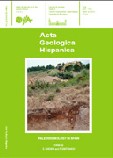Paleoseismic results from multiple trenching analysis along a silent fault: The El Camp fault (Tarragona, northeastern Iberian Peninsula)
Article Sidebar

Main Article Content
E. Masana
J. A. Villamarín
Pere Santanach
We present the paleoseismological analysis of the El Camp fault scarp. Paleoseismology constitutes the key methodology for any real estimate of seismic hazard in low-slip-rate areas with no reported historical earthquakes. The recent tectonic activity of this fault is evidenced by a young mountain front and a fault scarp which cuts Quatern a ry alluvial fans. A regional geological analysis indicates that three generations of alluvial fans are cut by the fault. Absolute (TL and U/Th) and relative datings show that the oldest fan is 300 ka old and the intermediate one is 125 ka old. The study of 7 trenches and the absolute datings performed (TL, U/Th, radiocarbon as well as pollen analysis) revealed the following: 1) the El Camp fault consists of two segments (the nort h e rn end of the southern segment is located close to Po rquerola creek); 2) only the southern segment has been active since 125 ka; 3) the fault is seismogenic because it is associated with liquefaction features and colluvial wedges; 4) the El Camp fault has produced at least three well constrained surface-rupturing earthquakes since 125 ka (events Z, Y, and X). Based on the different tectonic features observed in the trenches, the recurrence period of large earthquakes during this period was estimated to be around 30 ka and the elapsed time to be around 3000 yr. Using the fault length and the ve rtical displacement per event, the largest estimated earthquake had a magnitude of Mw 6.7.
Article Details
Com citar
Masana, E. et al. “Paleoseismic results from multiple trenching analysis along a silent fault: The El Camp fault (Tarragona, northeastern Iberian Peninsula)”. Acta geológica hispánica, vol.VOL 36, no. 3, pp. 329-54, https://raco.cat/index.php/ActaGeologica/article/view/75652.
Articles més llegits del mateix autor/a
- Pedro Anadón Monzón, Ferran Colombo, Mateu Esteban Cerdà, Mariano Marzo, Sergio Robles Orozco, Pere Santanach, Lluís Solé Sugrañes, Evolución tectonoestratigráfica de los Catalánides , Acta geológica hispánica: 1979: Vol.: 14 Núm.: 1
- E. Masana, Neotectonic features of the Catalan Coastel Ranges, Northeastern Spain , Acta geológica hispánica: 1994: Vol.: 29 Núm.: 2 -4
- P. Ferrer, E. Masana, Pere Santanach, Expresión geomorfológica de la actividad reciente de la falla de Amer (NE de la Península Ibérica) , Acta geológica hispánica: 1996: Vol.: 31 Núm.: 4
- Francesc Sàbat i Montserrat, Pere Santanach, Tectònica extensiva d'edat juràssica a l'illa de Cabrera (Balears) , Acta geológica hispánica: 1984: Vol.: 19 Núm.: 4
- Pere Santanach, E. Masana, Prospects for Paleoseismology in Spain , Acta geológica hispánica: 2001: Vol.: 36 Núm.: 3 -4
- J. J. Martínez Díaz, E. Masana, J. L. Hernández-Enrile, Pere Santanach, Evidence for coseismic events of recurrent prehistoric deformation along the Alhama de Murcia fault, southeastern Spain , Acta geológica hispánica: 2001: Vol.: 36 Núm.: 3 -4
- F. Domingo, J. A. Muñoz, Pere Santanach, Estructures d'encavalcament en els materials del sòcol hercinià del massís de la Tosa d'Alp (Pirineu oriental) , Acta geológica hispánica: 1988: Vol.: 23 Núm.: 2
- Jordi , (Carreras Planells) Carreras, Pere Santanach, Presiciones acerca de la significación petrológica y estructural de las rocas gneísicas y cataclásticas del Maresme (prov. de Barcelona) , Acta geológica hispánica: 1975: Vol.: 10 Núm.: 2
- Pere Santanach, Estudio tectónico del Paleozoico inferior del Pirineo entre Cerdaña y el río Ter , Acta geológica hispánica: 1972: Vol.: 7 Núm.: 2
- Mateu Esteban Cerdà, Pere Santanach, Deslizamientos gravitacionales y olistromas miocenos en el bajo Gaià y Campo de Tarragona , Acta geológica hispánica: 1974: Vol.: 9 Núm.: 4